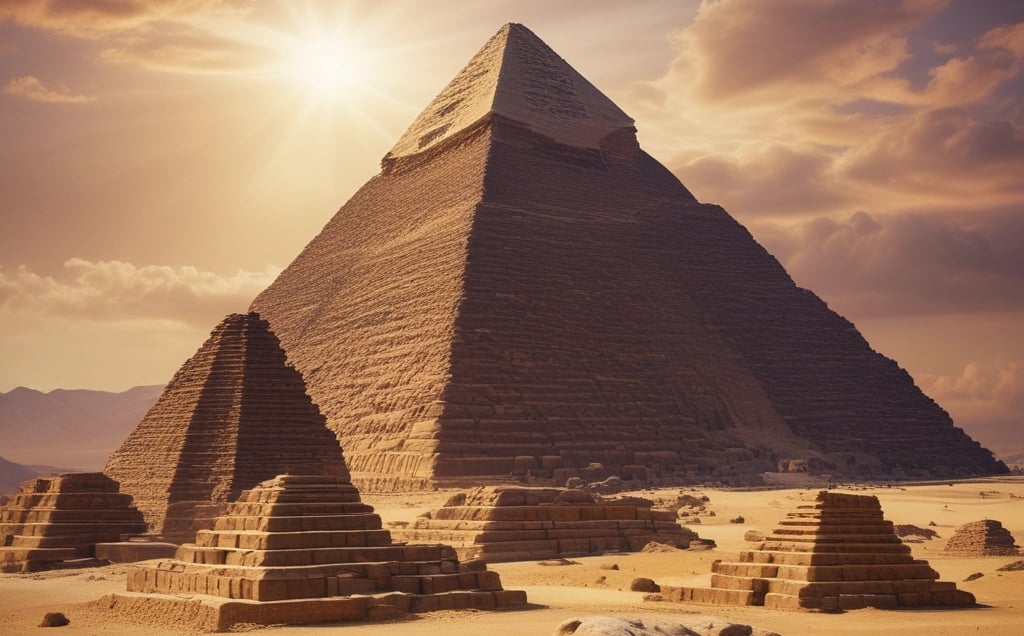𝗨𝗡𝗩𝗘𝗜𝗟𝗜𝗡𝗚 𝗧𝗛𝗘 𝗠𝗬𝗦𝗧𝗘𝗥𝗜𝗘𝗦 𝗢𝗙 𝗣𝗬𝗥𝗔𝗠𝗜𝗗𝗦: 𝗗𝗜𝗦𝗖𝗢𝗩𝗘𝗥𝗜𝗘𝗦 𝗢𝗙 𝗧𝗛𝗘 𝗟𝗔𝗦𝗧 𝗗𝗘𝗖𝗔𝗗𝗘
𝗨𝗡𝗩𝗘𝗜𝗟𝗜𝗡𝗚 𝗧𝗛𝗘 𝗠𝗬𝗦𝗧𝗘𝗥𝗜𝗘𝗦 𝗢𝗙 𝗣𝗬𝗥𝗔𝗠𝗜𝗗𝗦: 𝗗𝗜𝗦𝗖𝗢𝗩𝗘𝗥𝗜𝗘𝗦 𝗢𝗙 𝗧𝗛𝗘 𝗟𝗔𝗦𝗧 𝗗𝗘𝗖𝗔𝗗𝗘
MYSTERIES & ARCHAEOLOGYGOSPEL AND SPIRITUALITY
MrTruth.Tv
12/2/20253 min read


Introduction to the Enigmatic Pyramids
The great pyramids of Egypt have puzzled historians, archaeologists, and enthusiasts for centuries. Standing as monumental feats of engineering, these ancient structures hold secrets that continue to fascinate the modern world. In the last decade, technological advancements and exhaustive research have unveiled intriguing discoveries regarding these iconic tombs. This article discusses some of the most compelling revelations about the pyramids that have emerged over the past ten years, highlighting not only their architectural grandeur but also the cultural and historical contexts that motivated their construction.
Recent Findings and Discoveries
One of the most groundbreaking discoveries took place in 2020 when scientists utilized a technique called muon tomography. This innovative method enabled them to reveal internal structures within the Great Pyramid of Giza—a feat that had eluded researchers for years. The scan confirmed the existence of a previously unknown void, approximately 30 meters long, above the Grand Gallery, suggesting that there are more secrets hidden deep within the structure. This notable discovery sparked curiosity and excitement within both the scientific community and the public, as it raised questions about what else might be concealed within the walls of the pyramid.
Additionally, researchers have uncovered clues about the construction techniques used to build these architectural marvels. Evidence from ancient papyri, which was discovered in the 1990s but analyzed more fully in the last decade, has unveiled new insights into how workers transported heavy stone blocks from quarries to the construction sites. These findings indicate that the use of water lubrication may have played an essential role in easing the laborious process of moving enormous materials. Moreover, the potential for a highly organized workforce suggests a remarkable level of planning and social cooperation among the ancient Egyptians, who were motivated by a complex blend of religious beliefs and socio-political factors.
Technological Innovations in Archaeology
The involvement of technology in archaeological practices has significantly improved our understanding of the pyramids. 3D laser scanning and drones have facilitated accurate mapping and analysis of pyramid sites. In the past few years, these technologies have provided us with significant data on the layout of pyramids and their surrounding structures. For example, researchers have identified a network of ancient pathways that hint at the transportation routes used by laborers. These pathways, along with the analysis of surrounding artifacts, offer a glimpse into the daily lives of the laborers and the logistics involved in the pyramid's construction.
Furthermore, the use of artificial intelligence (AI) has become instrumental in analyzing vast amounts of archaeological data. AI has helped researchers find patterns in the distribution of artifacts associated with pyramid sites, leading to more informed theories regarding the rituals and daily lives of those who built these grand tombs. Such advancements pave the way for future breakthroughs in understanding the society that constructed these remarkable edifices. The intersection of AI with traditional archaeological methods is revolutionizing how we approach ancient mysteries, allowing us to synthesize vast quantities of data in ways that were previously unimaginable.
Conclusion: Continual Unraveling of Secrets
The last ten years have revealed significant advancements and discoveries concerning the mysteries surrounding pyramids. From high-tech scanning techniques that unveil hidden chambers to the exploration of transportation methods that aided their construction, each finding contributes to our knowledge of ancient Egyptian civilization. As research continues to evolve, historians and archaeologists are eager to delve deeper into the enigmas of these monumental tombs. Every unturned stone reminds us that the allure of the pyramids is far from complete, and the next decade holds the promise of even more astonishing revelations. The fascination with the pyramids intertwines with our quest for knowledge about the past; they stand not only as tombs but also as enduring symbols of human creativity, perseverance, and the mysteries that continue to inspire generations.



